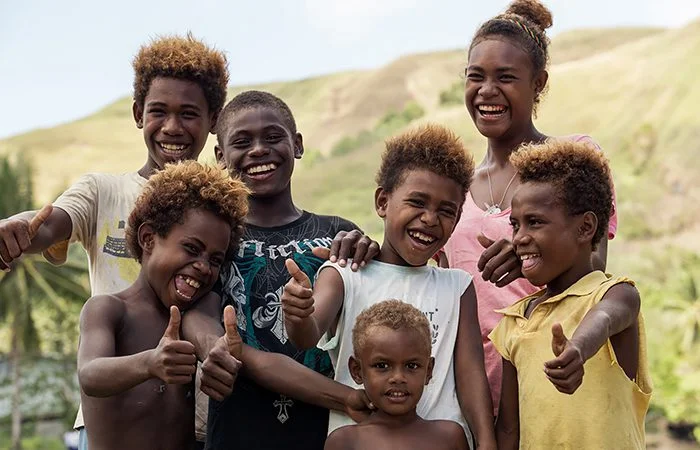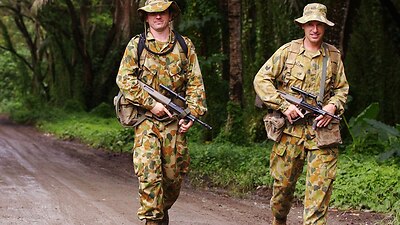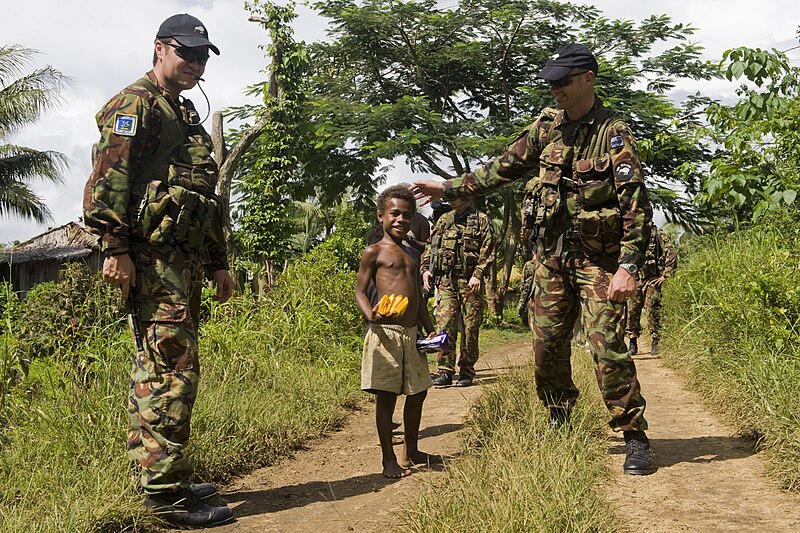
The Solomon Islands are a large widespread archipelago in the South Pacific. They’re largely known for their importance in World War II, in which the coalition of Allied forces began their pushback against the Japanese in the Battle of the Coral Sea and the Battle of Guadalcanal.
Solomon Islands consists of six primary islands and around 900 much smaller ones. The climate is equatorial (read: extremely humid) and the islands are prone to severe weather like earthquakes and cyclones. The Solomons lie east-southeast of Papua New Guinea, northeast of Australia, and northwest of Vanuatu and the French collectivity of New Caledonia.
The indigenous people of the Solomons are Melanesian, like their neighbors in Fiji, Vanuatu and Papua New Guinea; they and their lands were first discovered by Europeans in 1568. Álvaro de Mendaña, a Spaniard sailing on behalf of Peru, named them the Solomon Islands (for the namesake Biblical king) because he mistakenly thought that the islands contained gold deposits. In the 19th century, British and German explorers sparred over the islands, each hoping to establish Pacific territories there. The Germans established claims in the northern islands and the British in the south, much like they did in Papua New Guinea. After potential violence was averted elsewhere in the Pacific, the two colonial powers signed a treaty which allowed the Germans to claim Samoa, while the British received access to both Tonga and the Solomons, which they claimed as protectorates.

Solomon Islands’ position in the South Pacific.
The early years in the British Solomon Islands Protectorate were rough. There was intermittent violence between different tribes on the islands and against the Brits themselves. Economic development was slow and was mainly centered around copra plantations and small-scale logging and mining. Most islanders remained poor.
During WWII, American and Australian forces were stationed in the islands after reclaiming them from the Japanese military. The foreign visitors significantly upgraded the infrastructure on Guadalcanal, particularly in the capital of Honiara, and made a large cultural impact on the islands as well. Many Solomon Islanders served as coastwatchers, including Biuku Gasa and Eroni Kumana, who were the two indigenous men who helped rescue the PT-109 boat captained by future president John F. Kennedy.
After WWII, several indigenous groups, backed by workers’ unions, began working to gain independence. The British realized the writing was on the wall and gradually moved the Solomons toward self-government. They finally became independent on July 7, 1978 and remained in the Commonwealth of Nations.

The troubles started quickly after the Solomons became independent, however. A messy civil war was escalating on Bougainville Island, which was culturally part of the Solomons, but had been annexed as an autonomous region of Papua New Guinea. On Guadalcanal, ethnic tensions flared between natives of that island and from nearby Malaita. Two opposing nationalist militant organizations sprang up in the late ’90s to maintain their own interests by force if necessary. The Isatabu Freedom Movement (IFM) represented Guadalcanal, while the Malaita Eagle Force (MLF) stood for their own island’s interests.
The tensions arose not just from historic inter-tribal conflicts, but from land tenure issues and colonial era mismanagement of various plantations and enterprises. Many Malaitan civilians that got caught in the crosshairs had simply decided to move back to their own island — which they had just left in order to get better jobs on Guadalcanal. The country’s police force, which was ethnically divided, was left incompetent and incapable of preventing violence in Honiara. At one point, the MLF controlled Honiara and the IFM controlled the rest of Guadalcanal, raiding police stations for weapons and terrorizing civilians.
In late 1999, the Solomons’ prime minister, Bartholomew Ulufa’alu, was overwhelmed at the situation and declared a four-month state of emergency. The following June, MLF militia groups kidnapped Ulufa’alu, on the grounds that even though he was ethnically Malaitan, he wasn’t doing enough to protect their own interests. He resigned from office in exchange for his release, and former finance minister Manasseh Sogavare succeeded him in a controversial election.
That October, the Solomons government, the Guadalcanal regional government and the MLF signed a peace agreement in Townsville, Queensland, Australia. This largely did nothing to calm down the situation in Honiara; violence continued in southern Guadalcanal and crime and looting became rampant. Basic education and healthcare were non-existent. Government workers weren’t getting paid, and the minister of finance was literally forced to write checks at gunpoint. Sympathetic prison guards would abandon their posts routinely and allow dangerous prisoners to roam free. Thanks to significant extortion and scheming, the entire Solomons government was bankrupt by 2001. Governor-General John Lapli led a unanimous vote in Parliament to ask for international assistance.
That’s how the Regional Assistance Mission to Solomon Islands (RAMSI) was born.
RAMSI was a coalition of police, peacekeepers and military advisors largely supported by Solomon Islands’ largest two neighbors, Australia and New Zealand, who contributed roughly 8,900 and 130 personnel, respectively. Nick Warner, a Singapore-born Australian diplomat who was previously the Australian High Commissioner to Papua New Guinea, was named special coordinator for the operation. He was assisted by two deputies, Peter Noble from New Zealand and Sekove Naqiolevu from Fiji.

The vast majority of personnel were peace officers hired to retrain Solomon Islands military and police. The military component of the mission was largely led by the Australian Defence Force, as well as rifle battalions from Fiji and Tonga, a team of New Zealand engineers, and various combat support teams and medical operations. In 2003, RAMSI got a significant early victory when IFM warlord Harold Keke declared a ceasefire and surrendered to peacekeepers (he’s currently serving life in prison).
After November 2003, RAMSI primarily shifted its focus to internal policing and peacekeeping. Roughly 130 civilians — mostly Aussies and Kiwis — helped with logistics and coordination with restarting various industries on Guadalcanal. Additionally, a group of economic advisors were brought on board to help balance the Solomons budget, eliminate debt and restabilize the Solomon Islands dollar.
The response from the Solomon Islands government was muted, to say the least. Sogavare accused Australia of undermining the island’s sovereignty by setting up RAMSI as a puppet government alongside the actual Solomons government. Sogavare also claimed that Australia pressured other Pacific island nations to join RAMSI and he boycotted that year’s Pacific Islands Leaders meeting in Tonga in protest.
“Australia is not about to recolonise the South Pacific, nor should it. These are independent sovereign countries,” said then-foreign minister Alexander Downer. “Sending in Australian troops to occupy Solomon Islands would be folly in the extreme. It would be widely resented in the Pacific region. It would be very difficult to justify to Australian taxpayers. And for how many years would such an occupation have to continue?”

A potential international incident nearly occurred when Australian police officer Adam Dunning was ambushed and murdered while on patrol in December 2004. Thankfully, the two perps were arrested and charged the following month, but they were later acquitted in a 2007 trial.
Sogavare’s successor as prime minister, Derek Sikua, was much more positive about his country’s situation.
“I think for some time in the last 18 months, the Solomon Islands government was preoccupied with finding fault in RAMSI,” he said shortly after taking office in December 2007. “RAMSI is here on our invitation. [The mission] is important to Solomon Islands, as it provides security, development of our police service, and the strengthening of the capacity of government institutions.”
The optimism was short-lived.

In yet another contentious election, when Snyder Pini was named prime minister, riots broke out in Honiara’s Chinatown after allegations emerged that Pini had accepted bribes from prominent Chinese expat businessmen in the Solomons, who had, in turn, bribed the parliamentarians who had cast the deciding votes. Facing a vote of no confidence, Pini resigned and was replaced by Sogavare. Nine Aussie cops died in the riots.
From 2013-17, tensions gradually died down and RAMSI’s mission moved to strictly police training. The number of personnel dwindled and the mission formally concluded on June 30, 2017.

Was RAMSI a success? It depends on who you ask, and the issue remains contentious throughout the region.
“When you think of the pending departure of RAMSI, competing metaphors spring to mind,” said Nick O’Malley in a June 2017 article for the Sydney Morning Herald. “Is the Solomon Islands a novice cyclist, about to gain momentum after receiving a ready push, or an ailing patient, about to have its crutches kicked away?”
Australia took the lead in a very volatile situation in a neighboring country, just like it had done previously in 1999 when its northern neighbor, East Timor, declared independence following decades of Indonesian occupation. The Aussie support for East Timor backfired tragically in the October 2002 Bali bombing, in which numerous civilians — including 88 Aussie tourists — were killed by Indonesian terrorists in retribution. John Howard was prime minister during the unrest in both East Timor and Solomon Islands and was quick to state mission accomplished after RAMSI concluded.
“The intervention…is in part about reducing the danger that vulnerable Pacific island states will become havens for transnational crime, including terrorism,” Howard said in 2003.
Rod Brazier, Australian Ambassador to Solomon Islands, came to a similar conclusion when RAMSI finished. “Our region, under the auspices of the Pacific Islands Forum, has worked together through good times and bad for 14 years to ensure that the job that was started in July 2003 was finished…Australia will never shirk from its responsibilities in the Pacific, and the departure of RAMSI is certainly not the departure of Australia. We are here to stay and we will continue to support this country’s positive trajectory.”
One of RAMSI’s former coordinators, James Batley, now teaches at Australian National University. He claims that the intervention was in line with historic Australian foreign policy goals, namely that all threats come from the north and that failed states are just as dangerous as rogue, antagonistic ones.
While the militant groups have long since disarmed, many Solomon Islanders remain concerned about their country. They still distrust police and insist that corruption is still rampant. Many former MLF militants — or those with extremist ties — remain in positions of power in the federal government, and many police officers believe that there are still armed rebels hiding away on other islands, waiting to strike again.
Experts have claimed that Solomon Islands is effectively a failed state being propped up by foreign aid. Ross McDonald, a professor at Auckland University in New Zealand, disagrees. He claims that, broadly speaking, the Solomon Islanders live in very tight-knit communities, and that outside of Guadalcanal and Malaita, the islands were relatively peaceful for years. McDonald believes that the Solomons were forced to become a brand-new country with no cohesive national identity from the get-go.

Daniel Gay of the Lowy Institute — a non-partisan think tank in Sydney — published a lengthy criticism of RAMSI in May 2014, titled “RAMSI: How to blow $2.6 billion in a decade” — citing the price tag that Australia spent to stabilize its younger island neighbor. According to the article, that amount made up one-third of the Solomons’ annual GDP.
“For a donor to spend more than the host government over such a long period may be without precedent in the Pacific region, if not the world. Such huge public spending also contradicts the advice of RAMSI government advisers, which was to lower expenditure,” the article stated.
“Who knows what would have happened without RAMSI? Maybe the performance of economic and social indicators would have been even worse. But other island states in the region seem to have done all right.”

Data from the World Bank and from the UN Human Development Index shows that, even with RAMSI’s help, the Solomons still lag behind other Pacific island countries in numerous categories, including per capita income, literacy rates and healthcare quality.
Gay’s article also highlighted a number of problems with RAMSI that went relatively unnoticed at the time:
- A full 83% of RAMSI’s funding went to law-and-order funding and less than a tenth went toward revitalizing the local economy.
- RAMSI only began conducting surveys of Solomon Islanders in 2007, a full three years after the intervention began. Despite the concerns of everyday citizens regarding jobs, health and education services, funding was not adjusted accordingly.
- Out of the money dedicated for the Solomons’ economic development, very little went to infrastructure, which had been decaying on every island and had born the brunt of the damage during the most violent years.
- Access to quality water and electricity remains rare. Outside of Honiara, roads and airstrips are in terrible condition.
- One-quarter of Solomon Islanders live below the poverty line and children only go to school an average of 4.5 years.
“What most people want is not just security, but health, education and a better standard of living, which requires economic development,” Gay remarked.
“Economic growth would have created long-term stability and employment, and, in turn, the tax revenues for the state to provide for its citizens including hospitals, schools and, ultimately, security. Ploughing money directly into the police and law should always have been a short term measure; a stop gap until the country could fend for itself. Despite the goodwill and dedication of many of the figures involved with RAMSI, the mission ultimately did not allow Solomon Islands to stand on its own two feet and to operate as a successful independent economy.”
What are your thoughts on this whole situation? Can the Solomons become a happier and more cohesive place? Do Australia’s humanitarian missions need to be re-evaluated? Let me know in the comment section below.